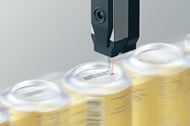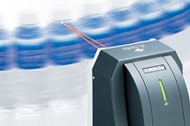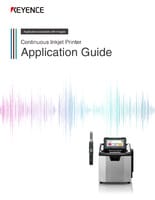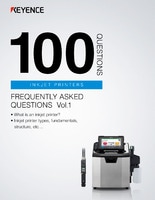Coding methods
Printing methods are divided into "contact marking" and "non-contact marking".
Contact marking
Handwriting
This is a method in which a person writes with a pen, which is the simplest and cheapest method. It is effective when production volume is small, however is very susceptible to human error and is not repeatable or consistent.
Stamping
There are basically two kinds of stamping: hand stamping and machine stamping. It is difficult to maintain printing quality due to the imprecise nature of stamping. Excess, or insufficient pressure can make marks unreadable. Stamping cannot reliably maintain quality on curved shapes or update characters in real-time for counter and date logs.
Labeling
Labels can be used to mark certain products. They often provide optimal contrasts and are clearly printed. Because of the separate production labels require, they normally incur a larger cost per part. It is also very easy for labels to peel off the product completely. They do not provide a permanent or reliable resolution within production.
Punching
Due to the nature of indenting in the surface of a product, the mark is permanent. Punching requires time to change the contents being marked, and is difficult to mark accurately. Marking on shapes that aren't flat is also impossible with this marking method.
Here’s the difference! Non-contact marking
Continuous Inkjet Printer

Continuous inkjet printers project ink onto a target to create lasting marks without coming into contact with the target. This method can print on curved and angled surfaces because of the lenient focal range inherent to this technology. One of the main advantages of CIJ is its ability to print at high-speeds while products are in motion. Continuous inkjet printers are also equipped with useful functions like automatic date updating. Variable data can be programmed in for easy operation when using counters, lot codes, date codes, or other constantly changing strings.
Laser marker

Characters are marked by moving focused light across X,Y, and Z planes. This technology has significant advantages since it does not require the use of consumables such as ink, or regular maintenance. Laser marking cannot be rubbed away or erased, so it is a viable option for permanent marking on most materials.
KEY POINTWhat are the advantages of non-contact marking?
Contact marking has to be done on a stationary target, even if the target is only stopping for an instant. This type of indexing creates problems for production lines that need to operate continuously. Non-contact marking allows for a continuous production line, such that manufacturing can continue to operate at high-speeds without any interruption. Non-contact marks are also preferable for soft and rounded applications where mark deformation may occur. For non-contact marking, there is no need to change marking plates or stamps, which makes it easy to change contents or products on the same line easily.
![Learn the Basics of Continuous Inkjet Printers [CIJ Central]](/Images/ss_products_inkjet_header_title_1785688.gif)



![Inkjet Printer Tech Guide [Basic Knowledge Edition]](/img/asset/AS_114378_L.jpg)



